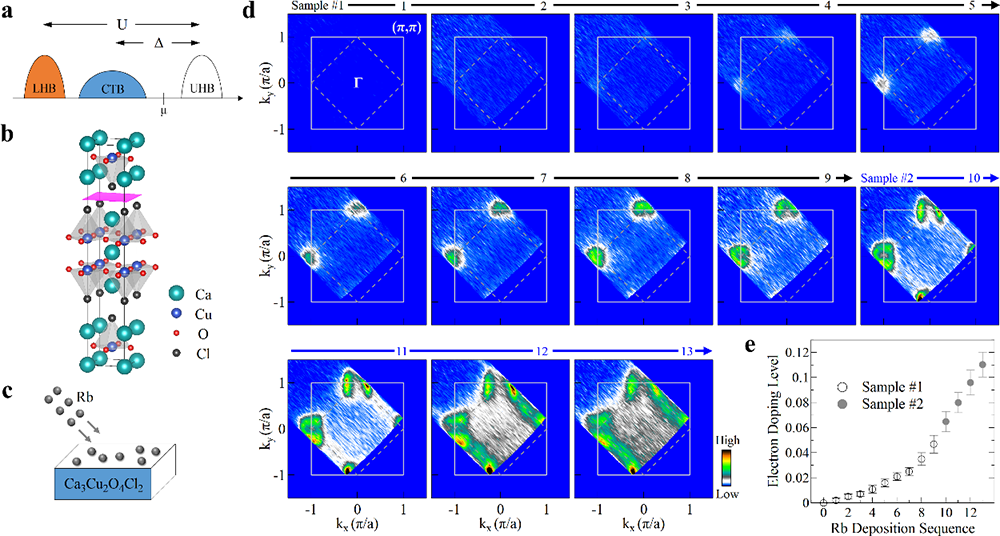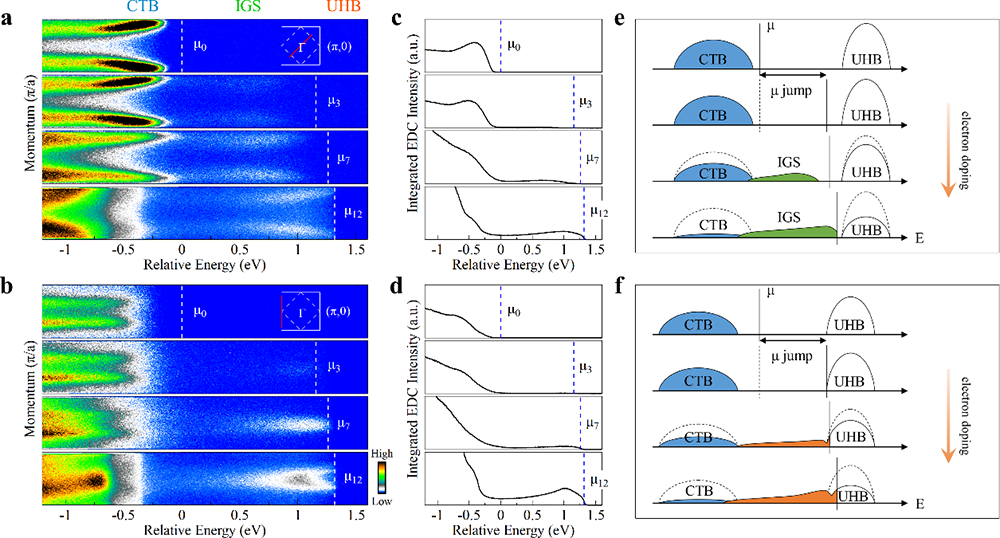Visualize the electronic evolution in doping a Mott insulator
Date:15-03-2021 Print
High temperature superconductivity in cuprates is realized by doping charge carriers into the antiferromagnetic parent Mott insulator. A key question is how such a Mott insulator can evolve into a conducting or superconducting state. The momentum-resolved electronic structure information of the parent Mott insulator and the lightly doped cuprates is essential to address these issues. However, no such information is available from Angle-Resolved Photoemission Spectroscopy (ARPES) measurements in the last thirty years because ARPES has not been able to probe the full Mott gap region due to the limitation of ideal parent compound and suitable doping technique.
Recently, Prof. Xingjiang Zhou's group from the Institute of Physics, Chinese Academy of Sciences, in collaboration with Prof. Changqing Jin's group and Prof. Tao Xiang, has made a significant progress in unveiling the electronic structure evolution of a cuprate Mott insulator by performing high resolution ARPES measurements. The researchers chose a new Mott insulator, Ca3Cu2O4Cl2 and employed a novel doping technique, Rb deposition, to in situ fine-tune the electron doping level. ARPES results reveal the electronic structure evolution in the Mott gap region (including the charge transfer band, Mott gap, and the upper Hubbard band) and make it possible to directly study its doping evolution and keep track of the emergence of the low-energy states.
Important results have been obtained to address the long-standing key issues: (1) The nature of the Mott gap. The researchers have demonstrated that it is an indirect gap of ~1.5eV; (2) How the Mott gap collapses with doping. With electron doping, the Mott gap shows little change in magnitude, but it collapses due to the spectral weight depletion of the charge transfer band and the filling-up of low-lying states in the gapped region; (3) How the low energy states emerge with doping. With electron doping, the low energy states emerge inside the gapped region. The newly developed in-gap states are incoherent that spread over a large energy range inside the gapped region; (4) Anisotropy of the in-gap states in the momentum space. Distinct doping evolution of the low-energy states is observed between the (π/2, π/2) nodal region and the (π,0) Brillouin zone face. These results provide fundamental information on the electronic structure evolution in doping a Mott insulator and establish a basis for developing microscopic theories in understanding high temperature superconductivity in cuprate superconductors.
This study entitled "Momentum-Resolved Visualization of Electronic Evolution in Doping a Mott Insulator" was published on Nature Communications. The study was supported by the National Natural Science Foundation, the Ministry of Science and Technology of China, and the Chinese Academy of Sciences.

Fig.1 Fermi surface evolution with Rb deposition. (Image by Institute of Physics)

Fig.2 Band structure evolution with Rb deposition. (Image by Institute of Physics)

Fig.3 Collapse of the Mott gap. (Image by Institute of Physics)

Fig.4 Full picture of electronic evolution in doping a Mott insulator. (Image by Institute of Physics)
Contact:
Institute of Physics
ZHOU Xingjiang
Email: XJZhou@iphy.ac.cn
Key word:
Cuprate, Mott gap, Electronic structure, Photoemission
Abstract:
How a cuprate parent insulator evolves into a conducting or superconducting state is a key issue in doping a Mott insulator and important to understand the physics for cuprate high temperature superconductivity. By high resolution angle-resolved photoemission spectroscopy, the electronic evolution of a cuprate parent Mott insulator within the entire Mott gap region is unveiled and the fundamental issues are addressed.

